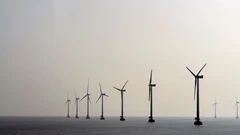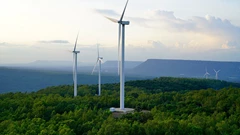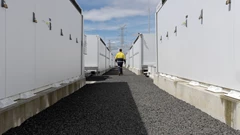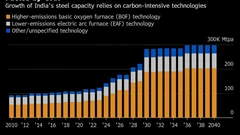World’s Biggest Carbon Market to Get Stronger in EU Green Shift
(Bloomberg) -- The European Union’s carbon market, the world’s biggest, is set to expand and impose tougher limits on emitters as the region aligns its entire economy with a stricter climate target for the next decade.
The European Commission plans to phase maritime transport into the EU Emissions Trading System from 2023 and improve a mechanism to control the supply of carbon permits as part of the biggest overhaul of the market to date, according to a draft law seen by Bloomberg News.
The reform, due to be unveiled on July 14, is also set to increase the rate at which the emissions caps shrink each year and to toughen the rules to get carbon allowances for free.
The changes are part of a broader package designed to tune every sector from energy to trade and cars in sync with an ambitious strategy that seeks to make Europe the world’s first climate-neutral continent by 2050. Under the Green Deal, the region’s 2030 emissions-reduction goal was deepened to at least 55% from 1990 levels. The previous objective was a cut of at least 40%.
“The ETS is a core instrument to help the EU achieve the increased 2030 target and a successful and just transition the 2050 climate neutrality,” the Commission said in the document.
Green Incentive
The EU carbon market is the 27-nations bloc’s flagship policy tool to cut greenhouse gases. It imposes annually declining caps on around 12,000 installations owned by manufacturers and utilities, and limits emissions from airlines. Companies that discharge less carbon can sell their unused permits, getting an incentive to go green faster.
While the ETS is currently designed to ensure a 43% cut in emissions by 2030 from 2005 levels, a recent EU analysis shows that if the legislation remained unchanged it would deliver a reduction of 51%, according to the document. That would still be insufficient to align the cap-and-trade with the new climate goal for the next decade.
That’s why the Commission, the EU’s executive arm, wants to increase the rate at which the pollution cap shrinks, the so-called Linear Reduction Factor. It would rise “from the year following the entry into force” of the amended emissions law. The legislation needs approval of national governments and the European Parliament in a process that frequently takes around two years and sometimes even more.
The exact value of the new LRF was left blank in the document. The faster pace of emissions cuts would be coupled with a reduction of the emissions cap so that it is “in line with this level of annual reduction having been applicable from 2021.”
Buffer Intake
Under the draft law, the EU executive also wants to improve the Market Stability Reserve, a key tool to withhold excess emissions permits. The MSR, which automatically soaks in allowances under certain conditions, helped restore investor confidence and drive prices higher after it was approved in 2018.

The reserve’s parameters would be modified to introduce a “buffer MSR intake” when the number of carbon permits in circulation is between 833 million and 1.096 billion. In that case, the amount of permits to be absorbed would be the difference between the number of permits in circulation and the 833 million threshold. As long as there are more than 1.096 billion allowances in circulation, including permits for aviation, the intake rate would remain at 24% until 2030.
To offer investors more predictability about permits held in the reserve as of 2023, their number would be limited to 400 million. Allowances above that level would be invalidated.
The Commission has a policy of not commenting on draft legislation. The proposal may still change before adoption.
The rules on benchmarks that set the basis for free allowances would be toughened and their allocation would be made conditional on decarbonisation efforts in order to encourage the uptake of low-carbon technologies.
Carbon Prices
Additionally, free permits would not be available to sectors covered by a planned carbon import levy. Under a separate draft regulation, the Commission is considering applying the so-called Carbon Border Adjustment Mechanism to industries such as steel, cement, aluminum, fertilizers and electricity.
The price of carbon in the EU ETS doubled over the past two years as Europe stepped up its climate ambition, luring in financial investors. The benchmark emission permits surged to a record 56.9 euros per metric ton last month and some hedge funds predicted it could reach 100 euros before year-end.
To alleviate concerns about the costs of the green transition, the Commission wants to change the way the governments use revenues from auctions of carbon permits and bolster ETS-based mechanisms to fund low-carbon technologies. EU nations would have to use all the revenues for climate-related purposes, including support for “low-income households’ sustainable renovation.”
The EU would also strengthen a special ETS-based fund for modernization in low-income member states. It would get revenues from auctioning an additional 2% of the cap to fund the energy transition.
Other elements of the carbon market report in the draft law include:
- The extension of the EU ETS to shipping
- The creation of an adjacent emissions trading program for heating and road transport
- The Introduction of Carbon Contracts for Difference, which offer investors in innovative technologies a fixed price that rewards carbon reductions above the current price level in the ETS
- Tougher rules for financing under the Modernization Fund, which will no longer support investments related to any fossil fuels
- Provisions to encourage carbon capture and utilization
More stories like this are available on bloomberg.com
©2021 Bloomberg L.P.
KEEPING THE ENERGY INDUSTRY CONNECTED
Subscribe to our newsletter and get the best of Energy Connects directly to your inbox each week.
By subscribing, you agree to the processing of your personal data by dmg events as described in the Privacy Policy.
More renewables news

With Trump Looming, Biden’s Green Bank Moves to Close Billions in Deals

GE Vernova Expects More Trouble for Struggling Offshore Wind Industry

Climate Tech Funds See Cash Pile Rise to $86 Billion as Investing Slows

GE Vernova to Power City-Sized Data Centers With Gas as AI Demand Soars

Longi Delays Solar Module Plant in China as Sector Struggles

Australia Picks BP, Neoen Projects in Biggest Renewables Tender

SSE Plans £22 Billion Investment to Bolster Scotland’s Grid

A Booming and Coal-Heavy Steel Sector Risks India’s Green Goals

bp and JERA join forces to create global offshore wind joint venture
















